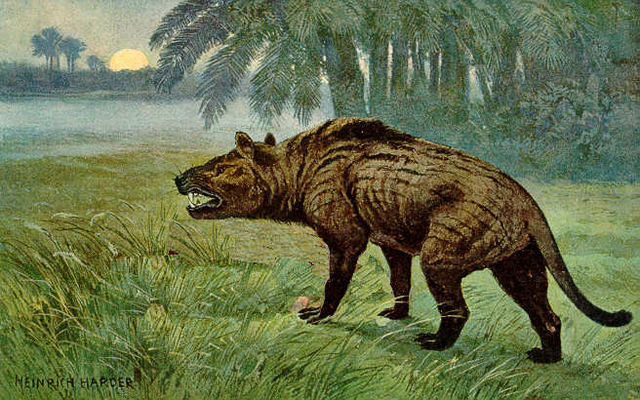Hyaenodon
Extinct genus of mammals From Wikipedia, the free encyclopedia
Hyaenodon ("hyena-tooth") is an extinct genus of carnivorous placental mammals from extinct tribe Hyaenodontini within extinct subfamily Hyaenodontinae (in extinct family Hyaenodontidae),[19] that lived in Eurasia and North America from the early Eocene, throughout the Oligocene, to the early Miocene.
| Hyaenodon | |
|---|---|
 | |
| Mounted H. sp. skeleton, Science Museum of Minnesota | |
| Scientific classification | |
| Domain: | Eukaryota |
| Kingdom: | Animalia |
| Phylum: | Chordata |
| Class: | Mammalia |
| Order: | †Hyaenodonta |
| Superfamily: | †Hyaenodontoidea |
| Family: | †Hyaenodontidae |
| Subfamily: | †Hyaenodontinae |
| Tribe: | †Hyaenodontini Leidy, 1869[1] |
| Genus: | †Hyaenodon Laizer & Parieu, 1838 |
| Type species | |
| †Hyaenodon leptorhynchus Laizer and Parieu, 1838 | |
| Species | |
|
[see classification] | |
| Synonyms[2] | |
|
synonyms of genus: synonyms of species:
| |
Description
Summarize
Perspective


Typical of early carnivorous mammals, individuals of Hyaenodon had a very massive skull, but a small brain. The skull is long with a narrow snout—much larger in relation to the length of the skull than in canine carnivores, for instance. The neck was shorter than the skull, while the body was long and robust and terminated in a long tail. Compared to the larger (but not closely related) Hyainailouros, the dentition of Hyaenodon was geared more towards shearing meat and less towards bone crushing.[20]
Some species of this genus were among the largest terrestrial carnivorous mammals of their time; others were only of the size of a marten. Remains of many species are known from North America, Europe, and Asia.[21] The average weight of adult or subadult H. horridus, the largest North American species, is estimated to about 40 kg (88 lb) and may not have exceeded 60 kg (130 lb). H. gigas, the largest Hyaenodon species, was much larger, being 378 kg (833 lb) and around 10 ft (3 m).[20] H. crucians from the early Oligocene of North America is estimated to only 10 to 25 kg (22 to 55 lb). H. microdon and H. mustelinus from the late Eocene of North America were even smaller and weighed probably about 5 kg (11 lb).[22]
Tooth eruption
Studies on juvenile Hyaenodon specimens show that the animal had a very unusual system of tooth replacement. Juveniles took about 3–4 years to complete the final stage of eruption, implying a long adolescent phase. In North American forms, the first upper premolar erupts before the first upper molar, while European forms show an earlier eruption of the first upper molar.[23]
Paleoecology
The various species of Hyaenodon competed with each other and with other hyaenodont genera (including Sinopa, Dissopsalis and Hyainailurus), and played important roles as predators in ecological communities as late as the Miocene in Asia and preyed on a variety of prey species such as primitive horses like Mesohippus, Brontotheres, early camels, oreodonts and even primitive rhinos.[20] Species of Hyaenodon have been shown to have successfully preyed on other large carnivores of their time, including a nimravid ("false sabertooth cat"), according to analysis of tooth puncture marks on a fossil Dinictis skull found in North Dakota.[24][25] Zigzag Hunter–Schreger bands in the enamel indicate that bone was a significant component of the diet of Hyaenodon.[26]
In North America the last Hyaenodon, in the form of H. brevirostrus, disappeared in the late Oligocene.[27] In Europe, they had already vanished earlier in the Oligocene.[21]
Classification and phylogeny


Taxonomy
- Tribe: †Hyaenodontini (Leidy, 1869)
- Genus: †Hyaenodon (Laizer & Parieu, 1838)
- †Hyaenodon brachyrhynchus (Blainville, 1841)[28]
- †Hyaenodon chunkhtensis (Dashzeveg, 1985)[29]
- †Hyaenodon dubius (Filhol, 1873)[30]
- †Hyaenodon eminus (Matthew & Granger, 1925)[31]
- †Hyaenodon exiguus (Gervais, 1873)[32]
- †Hyaenodon filholi (Schlosser, 1887)[33]
- †Hyaenodon gervaisi (Martin, 1906)[34]
- †Hyaenodon heberti (Europe, 41–33.9 mya) (Filhol, 1876)[35]
- †Hyaenodon leptorhynchus (Laizer & Parieu, 1838)[36]
- †Hyaenodon minor (Lange-Badré, 1979)[37]
- †Hyaenodon neimongoliensis (Huang & Zhu, 2002)[38]
- †Hyaenodon pervagus (Matthew & Granger, 1924)[39]
- †Hyaenodon pumilus (Lavrov, 2019[40]
- †Hyaenodon requieni (Gervais, 1846)[41]
- †Hyaenodon rossignoli (Lange-Badré, 1979)
- †Hyaenodon weilini (China, 23–16.9 mya) (Wang, 2005)[21]
- †Hyaenodon yuanchuensis (Young, 1937)[42]
- Subgenus: †Neohyaenodon (paraphyletic subgenus) (Thorpe, 1922)[43]
- †Hyaenodon gigas (Dashzeveg, 1985)
- †Hyaenodon horridus (Leidy, 1853)[44]
- †Hyaenodon incertus (Dashzeveg, 1985)
- †Hyaenodon macrocephalus (Lavrov, 1999)[3]
- †Hyaenodon megaloides (Mellett, 1977)[45]
- †Hyaenodon milvinus (Lavrov, 1999)[3]
- †Hyaenodon mongoliensis (Dashzeveg, 1964)[46]
- †Hyaenodon montanus (Douglass, 1902)[47]
- †Hyaenodon vetus (Stock, 1933)[48]
- Subgenus: †Protohyaenodon (paraphyletic subgenus) (Stock, 1933)
- Genus: †Hyaenodon (Laizer & Parieu, 1838)
References
Wikiwand - on
Seamless Wikipedia browsing. On steroids.
